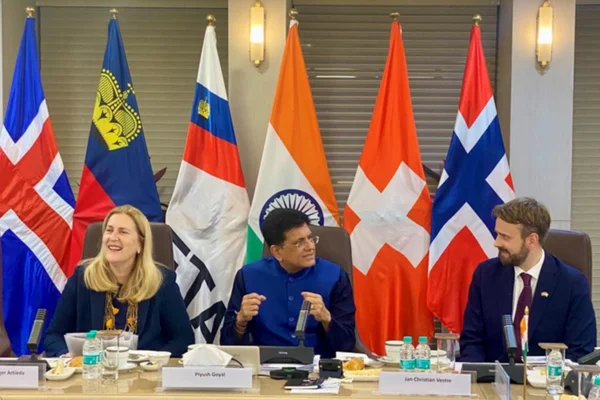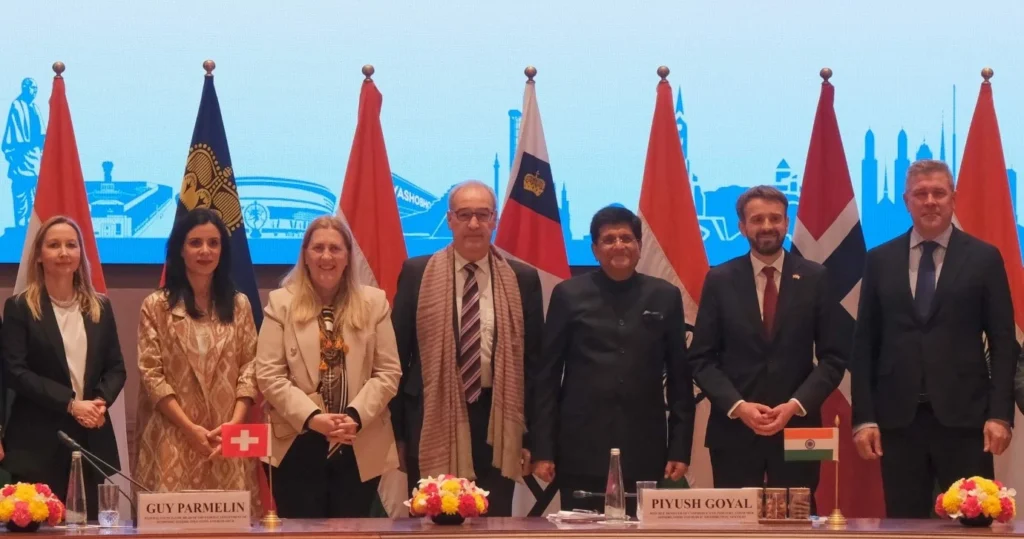India-European Free Trade Association recently signed a Trade and Economic Partnership Agreement (TEPA).
Key Highlights of the Agreement:
- India has been working on a Trade and Economic Partnership Agreement (TEPA) with EFTA countries comprising Switzerland, Iceland, Norway & Liechtenstein.
- For the first time, India signed FTA with four developed nations of Europe and a binding commitment of $100 bn investment, 1 million direct jobs in the next 15 years.
- Such investments do not cover foreign portfolio investment.
- It comprises 14 chapters with a main focus on market access of goods, rules of origin, trade facilitation, trade remedies, sanitary and phytosanitary measures, and technical barriers.
- This also includes investment promotion, market access on services, intellectual property rights, trade and sustainable development and other legal and horizontal provisions.
Specific economic parameters:
- EFTA is offering 92.2% of its tariff lines which covers 99.6% of India’s exports.
- The EFTA’s market access offer covers 100% of non-agri products and tariff concession on Processed Agricultural Products (PAP).
- India is offering 82.7% of its tariff lines which covers 95.3% of EFTA exports of which more than 80% import is Gold.
- Sensitivity related to PLI in sectors such as pharma, medical devices & processed food etc. have been taken while extending offers.
- Sectors like dairy, soya, coal and sensitive agricultural products are kept on exclusion list.
- India has offered 105 sub-sectors to the EFTA and secured commitments in 128 sub-sectors from Switzerland, 114 from Norway, 107 from Liechtenstein, and 110 from Iceland.
- Services offers from EFTA include better access through digital delivery of Services (Mode 1), commercial presence (Mode 3) and improved commitments and certainty for entry and temporary stay of key personnel (Mode 4).
Provision related to TEPA:
- TEPA would stimulate services exports in IT services, business services, personal, cultural, sporting, and recreational services, other education services, audio-visual services etc.
- TEPA has provisions for Mutual Recognition Agreements in Professional Services like nursing, chartered accountants, architects etc.
- Commitments related to Intellectual Property Rights (IPR) in TEPA are at the TRIPS (Trade-Related Aspects of Intellectual Property Rights) level.
- India’s interests in generic medicines and concerns related to the evergreening of patents have been fully addressed.
- TEPA provides an opportunity to integrate into EU markets, with over 40% of Switzerland’s global services exports are to the EU.
- TEPA will give impetus to “Make in India” and Atmanirbhar Bharat by encouraging domestic manufacturing in sectors such as Infrastructure and Connectivity, Manufacturing, etc.
- TEPA would accelerate creation many direct jobs for India’s young aspirational workforce in next 15 years in India, including better facilities for vocational and technical training.
- TEPA also facilitates technology collaboration and access to world leading technologies in precision engineering, health sciences, renewable energy, Innovation and R&D.
Benefits for India:
- The agreement will give a boost to Make in India and provide opportunities to young & talented workforce.
- The FTA will provide a window for Indian exporters to access large European and global markets.
- India signals its commitment to Sustainable development, inclusive growth, social development and environmental protection.
- Fosters transparency, efficiency, simplification, harmonization and consistency of trade procedures
- TEPA will empower India’s exporters access to specialized inputs and create a conducive trade and investment environment.
- This would boost exports of Indian-made goods and provide opportunities for services sector to access more markets.
- Among EFTA countries, Switzerland is the largest trading partner of India followed by Norway.
About European Free Trade Association (EFTA):
- It is the intergovernmental organization of Iceland, Liechtenstein, Norway and Switzerland.
- It was set up in 1960 by its then-seven Member States for the promotion of free trade and economic integration between its members.
- This offers several growing opportunities for enhancing international trade in goods and services.
- Its Headquarters is in Geneva, while its Secretariat operates in Brussels.
- The EFTA Council is the highest governing body of EFTA and meets eight times a year at the ambassadorial level and twice a year at the Ministerial level.
- The Chairmanship rotates every six months among its members.
- Three advisory bodies function under EFTA which include- Parliamentary Committee (PC), EFTA Consultative Committee (CC), and EEA EFTA Forum.
- The PC is a forum for parliamentarians in the four member states while the CC is comprised.
Ref:Source
| UPSC IAS Preparation Resources | |
| Current Affairs Analysis | Topperspedia |
| GS Shots | Simply Explained |
| Daily Flash Cards | Daily Quiz |



